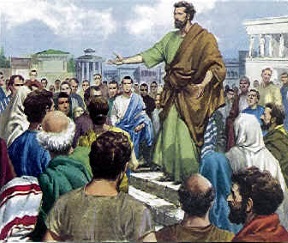The New Testament tells that Paul’s missionary vision was concentrated on serving the Gentiles. Being a strong enemy of Christianity, Paul became one of the greatest miracles of the New Testament and thus his life was a true representation of what a real mission is. There are several characteristics of missionary methods Paul uses in his service.
The first method that can be recognized is the so-called itinerant evangelism which lies in spreading the good news in every place on Earth. In other words, Paul “[calls] people everywhere in the then known world to repent and give themselves to Christ” (Moreau, Corwin, and McGee 2004). The accent is put on the fact that the Gospel is spread by Paul not in the place of his usual inhabitance but in the places, he would even never visit if it were not for God’s calling in his life. This method should be well understood by each Christian because often Church sees evangelism only locally. Paul provides a good method of making God’s will be done since the main commission consists in spreading the Gospel to the ends of the Earth. Paul’s method went beyond all borders of the average human mind- he committed himself to go anywhere God would send him, whatever it cost him. Another important method used by Paul in his evangelism is following the inspiration of the Holy Spirit. It is evident from the Scriptures that Paul was led by Holy Spirit in every decision he made. It even turned out sometimes that the places he wanted to visit were not part of God’s plan so he successfully avoided traveling there. Thus, “in a blend of Spirit-led decisions and divine revelations, Paul moves from one city to another” (Moreau, Corwin and McGee 2004). Of course, since mission is God’s will first, and each missionary should follow this rule, but Paul’s life is a true example of how missionaries should accomplish their calling in preaching the Gospel to the ends of the Earth.
The next characteristic of Paul’s missionary methods that may be traced from the life of Paul is total fearlessness. Paul did not appreciate his earthly life at all but considered God’s mission to be the main purpose. It is clear that Paul’s mission consisted in fulfilling God’s will even at the cost of his own life, and his daring heart allowed him to return to places full of danger. Therefore, “modern Christians may wonder what Paul’s feelings were as he returned to Lystra, where recently he had been stoned and left for dead…” but this seems to be “a nonissue” for Paul as he was straight-out for mission (Moreau, Corwin and McGee 2004). Paul’s methods were radical enough: he exposed people’s sins and also was not afraid to die for the truth. One more important characteristic of Paul’s missionary methods is that he never left those he converted to Christianity without spiritual help and support. To be more precise, despite his calling consisted of going to the nations and spreading the Gospel to the ends of the Earth, he still considered it important to support the planted churches. He does this in the face of persecutions and tries to fulfill his promise to visit the churches at all costs, though still, he is every time led by the Holy Spirit.
The last characteristic is presenting Gospel to all people, regardless of their background. Paul “was willing to adapt in different places a radically different approach, as he put it, “for those under the law and for those not under the law” (Winter and Hawthorne 1981). This was one of the most crucial characteristics of Paul’s mission because it triggered many contradictions among the Jewish people and Pharisees. His message was as contradictory and difficult to accept as the message of Jesus Christ. This is the testimony of Paul’s true devotion to the teaching of Christ. As His disciple, Paul followed the main principle Jesus Christ used: God loved the world and wants every human being to be saved. All in all, Paul’s missionary methods fully express the essence of the Gospel: God’s love to people at all cost.
References
Moreau, A. Scott, Gary Corwin, and Gary B McGee. 2004. Introducing World Missions. Grand Rapids, Mich.: Baker Academic.
Winter, Ralph D and Steven C Hawthorne. 1981. Perspectives on The World Christian Movement: Reader. Pasadena, Calif.: William Carey Library.


Leave a Reply
You must be logged in to post a comment.